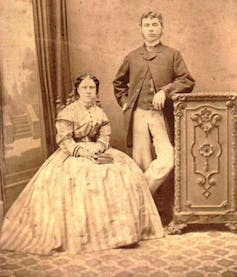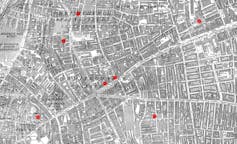 This and other clues led him and Katherine Watson, an Oxford historian, to publish an academic paper on their Ripper theory earlier this year.
This and other clues led him and Katherine Watson, an Oxford historian, to publish an academic paper on their Ripper theory earlier this year.Featuring the latest news and theories in the 130-year-old worldwide quest to identify the person dubbed Jack the Ripper, responsible for the murder of 5 common prostitutes around the seedy district of Whitechapel in London's notorious East End between 31 August 1888 and 9 November 1888. Will this serial killer's identity ever be revealed through DNA or other evidence?
Translate
Picture of Buck's Row Whitechapel in London's East End (now Durward St) - site of Jack the Ripper's first murder on 31 August 1888. Mary Ann "Polly" Nichols' body was discovered 3 metres back from the corner of the tall brick building.
Take a Ripper virtual tour from the first murder scene. Click on the map below to view all 5 murder scenes and other key locations in the hunt for the world's first recognised serial killer.
Buck's Row Whitechapel
Jack the Ripper's London 1888
This link will take you to the key points in London where Jack the Ripper carried out his 5 murders
over 71 days from 31 August 1888 to 9 November 1888. You can use this map to make your own Jack the
Ripper walk around London or to trace the movements of the Whitechapel killer whose identity has
never been established.
Jack the Ripper: New theory links sexual violence and a meatworker
 This and other clues led him and Katherine Watson, an Oxford historian, to publish an academic paper on their Ripper theory earlier this year.
This and other clues led him and Katherine Watson, an Oxford historian, to publish an academic paper on their Ripper theory earlier this year.BBC History: Jack the Ripper - London's East End serial killer 1888
 |
| Will Jack the Ripper ever be revealed? |
Original report: http://www.bbc.co.uk/history/historic_figures/ripper_jack_the.shtml
Jack the Ripper was a serial killer who disembowelled women
 |
| Annie Chapman is said to be the second victim of Jack the Ripper. |
 |
| The sites of the first seven Whitechapel murders – Osborn Street (centre right), George Yard (centre left), Hanbury Street (top), Buck’s Row (far right), Berner Street (bottom right), Mitre Square (bottom left), and Dorset Street (middle left). By Ordnance Survey; modified by User:ΑΩ |
A cultural icon
Original link: http://theconversation.com/jack-the-ripper-was-a-serial-killer-who-disembowelled-women-we-need-to-stop-celebrating-that-84080

